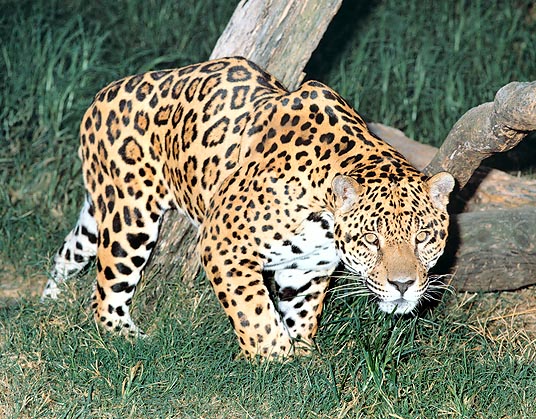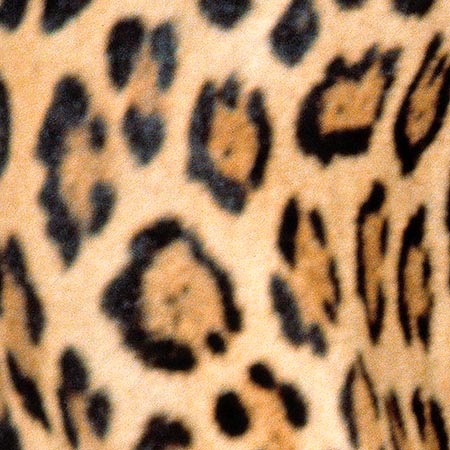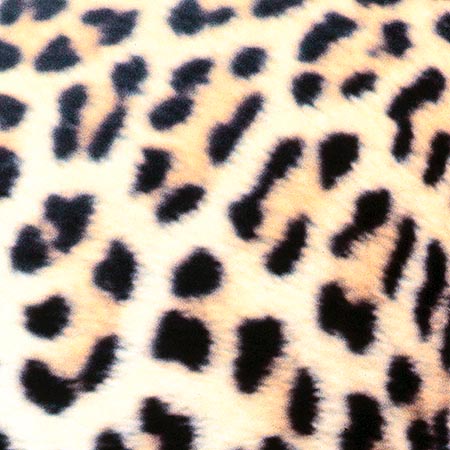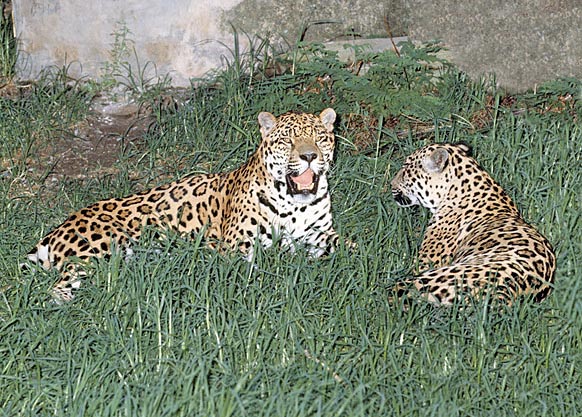Family : Felidae

Text © DrSc Giuliano Russini – Biologist Zoologist

English translation by Mario Beltramini

The jaguar looks like the leopard, but is bulkier, with shorter legs © G. Mazza
Even if the taxonomic classification attributes the description to the biologist Linnaeus, during the XVIII century, this species had been already sighted in the XVI by some Spanish biologists, during the conquest and colonization of Central and South America, in particular in the forests and the bush of the regions corresponding nowadays to Mexico, Costa Rica and Ecuador.
Second-largest feline after the Lion (Panthera leo) and the Tiger (Panthera tigris) the jaguar has adapted to several habitats: from the pluvial-tropical forests of Centre and South America, to the prairies, bush and arid and rocky areas typical of southern USA, such as New Mexico, Arizona and Texas. But we find it also in the forests and swamps of Florida, even if, in the whole, its density of population is very low in USA due to the concurrence of the Cougar (Felis concolor).
Like lions and tigers, the Panthera onca is subdivided in several subspecies, whose morpho-physiologic differences are caused by geographic isolation phenomena, mutations, and, in some instances, by cases of hybridization with other feline species. Presently, we identify eight different subspecies: Panthera onca onca, Panthera onca veraecrucis, Panthera onca goldmani, Panthera onca peruviana, Panthera onca centralis, Panthera onca palustris, Panthera onca arizonensis, Panthera onca hernandesii. The differences concern mainly the body dimensions, the colour and the maculation of the coat. The rosettes formed by the spots on the rusty coloured background, can, for instance, contain one or two black points in the centre. This combination differs in the various subspecies, keeping however in mind the great variability between the various specimens. In fact, two specimens identical for colour and composition of the coat do not exist.
The Panthera onca were and are strongly rooted in the tribal culture of the various central and South American populations, as well as of the Amerindians, autochthonous in southern USA. In Central and South America, they were considered as sacred animals by the Aztecs, Incas and Mayas. In several archeologic findings, such as statuettes and paintings, belonging to these important and mysterious civilizations, there are often references to the jaguar, along with the serpent, the eagle and the condor. The non-biologist can mistake, in the zoological gardens, zoo-safaris, zoo-parks, the jaguar with the leopard, as they have a coat similar at first sight as maculation and chromatism. Both adapt very well to captivity status, where they contribute to the repopulation of the species as they reproduce all over the year, and spend most of the day dozing while hanging loosely from the branches, the limbs lolling, ignoring the visitors, typical and unmistakable characteristic of these two species. But, in reality, there are many differences. First of all, the jaguar is endemic to Americas, whilst the leopard is endemic to Africa and Asia. Furthermore, the Panthera onca has a rusty-red coat with rosette-shaped drawings, with one or two black points inside, whilst the coat of the Panthera pardus is yellowish, with round and full spots, or, at least, less variegated than those of the jaguar. Finally, the leopard is smaller, with less robust limbs. In common, they have a long tail, which can be more than 70 cm long. It is useful for keeping the balance on the branches of the trees, and renders them the best climbers among the felines.
In both species there are melanistic variants (black) in the thicket of the South-American, African and Asiatic pluvial forests: the melanistic jaguar is frequent in the forests of Costa Rica along with the black panther which well hides in the darkness and the shade of the jungle. Such a coat could not in fact exist in the plains of Patagonia, or in the African and Asiatic prairies, where a moving black spot is easily visible by the preys, as what in the darkness is an advantage, in this case should reveal as a handicap. While observing well the coat of these melanistic animals under the sunshine, we always see the presence of rosettes or round spots typical of the species. Contrarily to what was thought till about twenty years ago, it is not then matter of hybrids born from inter-specific couplings, but a mutation depending from one of the different genes involved in the chromatism of the coat. In a word, an over-expression of melanin which covers the original coat. The phenomenon seems to be more frequent in the jaguars than in the leopards. A strict environmental and ecological link, connected to the biotope, might be its cause. After the theory of some biologists in the sixties, later on abandoned (too hastily, I think), this melanism, originated by one or more mutations of a multifunctional, pleiotropic gene, in charge of the colouration of the coat, might be due to a non-pathogenic virus (which does not have any consequence on the animal’s health), something similar to what happens for the tulips, where, as it is well known, the viruses create unusual streaks on the flowers.

The black rosettes of the jaguar have black points in their centre © G. Mazza
The melanism can finally be related to beneficial mutations in the immune system. It seems that the melanistic subjects (both jaguars and leopards) have an immune responsive activity, towards some infectious agents (protozoa, fungi, bacteria, viruses) which is better than in the wild-type specimens of the same species, but all this, for the moment, is still an hypotheses to be tested. At the Bear Creek Sanctuary of Barrie, in Canada, they have coupled a black jaguar with a lioness, which has generated a coal coloured female of “black jaglion” and a pale brown male of “maculated jaglion”. We cannot therefore affirm that the mutated gene of the melanistic jaguar is dominant on the colouration of the lion, other studies of formal genetics are necessary for knowing this. In any case, many zoologist biologists see, in the remarkable resemblances between the jaguar and the leopard, the clear sign of a common phylogenetic lineage.

The spots of the leopard are full on a yellowish background © Giusppe Mazza
Zoogeography
The Panthera onca is endemic to the southern part of USA (where, to say the truth, are rare), in states such as Texas, Arizona, New Mexico and Florida. In Central American they are found mostly in Mexico and Costa Rica (where the melanistic race is more concentrated), and in South America, where the major density is in Ecuador, Peru, Brazil, Argentina, Bolivia, Venezuela, Colombia, Uruguay and Paraguay.
Habitat-Ecology
Depending on the regions where it’s living, the jaguar can be found in different biotopes and habitats, even if the most frequent one is formed by the evergreen tropical pluvial forests. But, quite frequently, the biologists working for the conservation of the species, have sighted specimens up to 3200 metres of altitude above sea level, in the Peruvian and Colombian pluvial forests. This tells us how is complete and complex their physiology which allows them to live and hunt at such altitudes. In Central America, it is met in the forests of Costa Rica, whilst in South America, it lives in Ecuador, Peru, Brazil and Colombia, in the Amazon jungle. We find it also in the plains of the Argentine Pampas and near to humid zones, with marshes and reed beds. In fact, the jaguars are good swimmers, and willingly complete their diet, based on herbivores and rodents, with aquatic reptilians, amphibians and fish. In Argentina, they reach Patagonia, where, often, they effect slaughters of livestock. Finally, we find them in the Pantanal, the largest world’s wetland, extending from Brazil (Mato Grosso and Mato Grosso do Sul) to part of Bolivia and Paraguay. In these regions, where is present the giant Anaconda ( Eunectes murinus ), encounters and fights may happen between these two animals, and the jaguar is almost always the winner.
In southern USA, where, as we have seen, their density is low, their ranges can overlap on the cougar’s ( Felis concolor ), much more common. An overlapping of alimentary ecology which causes fights and hybridizations at times. As it happens for the Tiger ( Panthera tigris ), the Panthera onca usually creates its own living range, delimited by urines, roars and visual signs, at the centre of which it rests, usually on a tree, dozing during the day, even for eleven consecutive hours. Only by the sunset, it comes down to its home-range, looking for water and preys, which are identified by the sight or the smell. The possibility to retract the claws allows the jaguar to walk on the pads under the toes, thus reducing the noise, and to follow, without being seen, a prey for several kilometres, before jumping on it. Often the home range of a male overlaps that of different females, with which it can mate. Like the tiger, the Panthera onca is a solitary animal. It gets close to the females only when these are in oestrum, attracted by the roars of the future partner and by the smell of the vaginal pheromones, which it can be felt even by a distance of three km. In rare instances it may happen to meet a couple of males moving together, even in the combination of melanistic and wild-type. Usually it is matter of sub-adults, which are not living anymore with their mother and do not get in competition because not yet sexually mature.
Morpho-physiology
The identity card of a Panthera onca tells us that the males can reach even the 2 m of length, with a weight of 130 kg. The females about 1,70 m of length and 55-90 kg of weight. Both can reach, at the withers, the 60 cm of height. In spite of having almost the same morphology, the jaguar is much more robust than the leopard, with a muscular mass which reminds the lions and the tigers. It has short and stocky limbs, stronger than the leopard’s ones. With the front limbs, like the lion and the tiger, it can knock down big size preys, even 2-3 times heavier than it, such as the Tapir ( Tapirus terrestris ). It willingly eats also the Agoutis ( Azarae dasyprocta ), the Peccaries ( Tayassu pecari ), the Red Brockets ( Mazama americana ), the Capybara ( Hydrochoerus hydrochaeris ) and Fallow Deers ( Dama dama ) introduced by man, not to talk about cattle (Bos taurus) and domestic sheep ( Ovis aries ). Like lions and tigers, it uses its claws, which are retracted in a covered sheath, for knocking out the great preys, and kills them by suffocation with a bite on the neck, allowed by its powerful canines which can be 5 cm long and with a 3 cm root.
The maculated coat, with rosette-like drawings and black points inside, disguises it between the plants, while the reddish colouration of the coat, with rusty dots inside the rosettes, imitates the rays of the sun passing through the thick vegetation. The head is robust, as the neck, and in both sexes the nose has a pigmentation changing, while growing, from pink to black. The tail, 48-75 cm long, is useful for keeping balance between the branches of the trees, and its agility in climbing permits the animal, when herbivores and rodents are missing, to eat monkeys and various species of birds, like, for instance, the Psittaciformes. The short limbs do not allow long runs at high speeds, but the jaguars are very resistant in walking, and have a striking short sprint.

Pair of jaguars © Giusppe Mazza
Ethology and Reproductive Biology
As previously mentioned, jaguars spend most of their existence alone. They delimitate their own territory by abundant urinations rich in specific pheromones, but they utilize also visual signals, by scratching with their powerful claws the trunks of the trees, and acoustic ones, by their roars. If a female transits in its territory, even if not in oestrum or if accompanied by the cub, it is not attacked. If, on the contrary, it is in oestrum, the copulation takes place. The heat in the male is caused by the sexual status of the female, and, in order to know if the same is receptive, it smells its vagina and tastes the urines, a way also to evaluate its health condition, as in nature it is better to couple with a partner which can give a healthy and robust offspring.
While hunting, as previously said, the Panthera onca knocks down by blows of the fore limbs the big preys, such as the tapirs, then suffocates them with a bite on the neck; when the preys are smaller, the technique consists, on the contrary, in jumping on the animal, for instance a capybara, and piercing its skull with the strong canines. The jaguar attacks, kills and often eats small caymans which it seizes, like fish and amphibians, along the water streams. The ferine teeth allow the jaguar to tear off the flesh, which it swallows without chewing, whilst the carnassials, present also in lions, tigers, leopards, cougars, cheetahs and in the preminent carnivores, defined as secondary and tertiary consumers, allow the fragmentation of the bones. Due to its much differentiated alimentary ecology, the jaguar is therefore classified between the euryphagous organisms. The seizure of a prey is followed by the meal, which always begins with the liver of the killed animal, as this organ is rich of vitamin A, needed by the jaguar. During the first meal, a Panthera onca can consume even 5 kg of meat. Then its carcass is taken on a tree or hidden in the shrubs, for getting food during the following two days. When it putrefies, the jaguar discards it, contrarily to the leopard which is a real sweeper.
Coupling is characterized by numerous intercourses lasting a few seconds each. It can take place all over the year, as in the pluvial forest there is not a rainy season to which associate, let’s call it, a couplings schedule. The high number of intercourses between the two partners and the high frequency of unions between different partners, both males and females, increases, as for the Panthera leo, the reproductive chances. The ovules produced by the female, in fact, deteriorate quickly in the ovarian tube so the repeated couplings increase the probability of fecundation of the oocytes and consequently the survival of the species. On an average, 2-4 cubs come to life, after a 90-105 days long gestation. Uniparous deliveries are rare. The placentation is endotheliochorial with zonal organization. The cubs are bred by the female only, as the male gets away just after the coitus. Like the baboons (Papio cynocephalus), queerly, in these animals are present the so-called post-coitus cries. Maybe they announce the happened fecundation. Their nature and function, in both animals, is still mysterious for the biologists. Suckling lasts 3-4 weeks, then the weaning starts. The cubs remain with their mother till the age of 2 years, when both males and females reach the sexual maturity (in some specimens this may happen when three years old). Then, each one will go on its own way, looking for a territory.
The population of Panthera onca, melanistic and various subspecies included, is more and more threatened by the deforestation caused by the mining companies and by the cultivation of oil palms, banana trees, and, more recently, also by soya. The reductions in the number of specimens are drastic, almost reaching unbearable values, incompatible with the preservation of the species in the wild. For such reasons, the IUCN, along with the CITES, the WWF and several associations of zoological gardens such as the WAZA, the EAZA, in team with Central-South American and North American biology and zoology foundations have created projects for the conservation of the species and of the different subspecies, placing the Panthera onca, as protected species, in the long red list of the Threatened Endangered Species.
→ For general information about Felidae please click here
